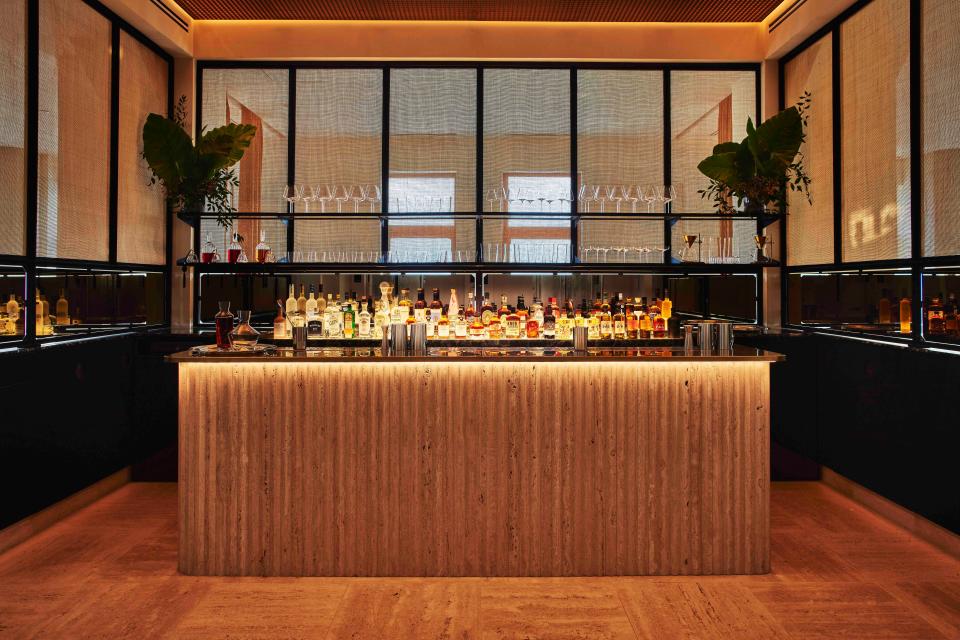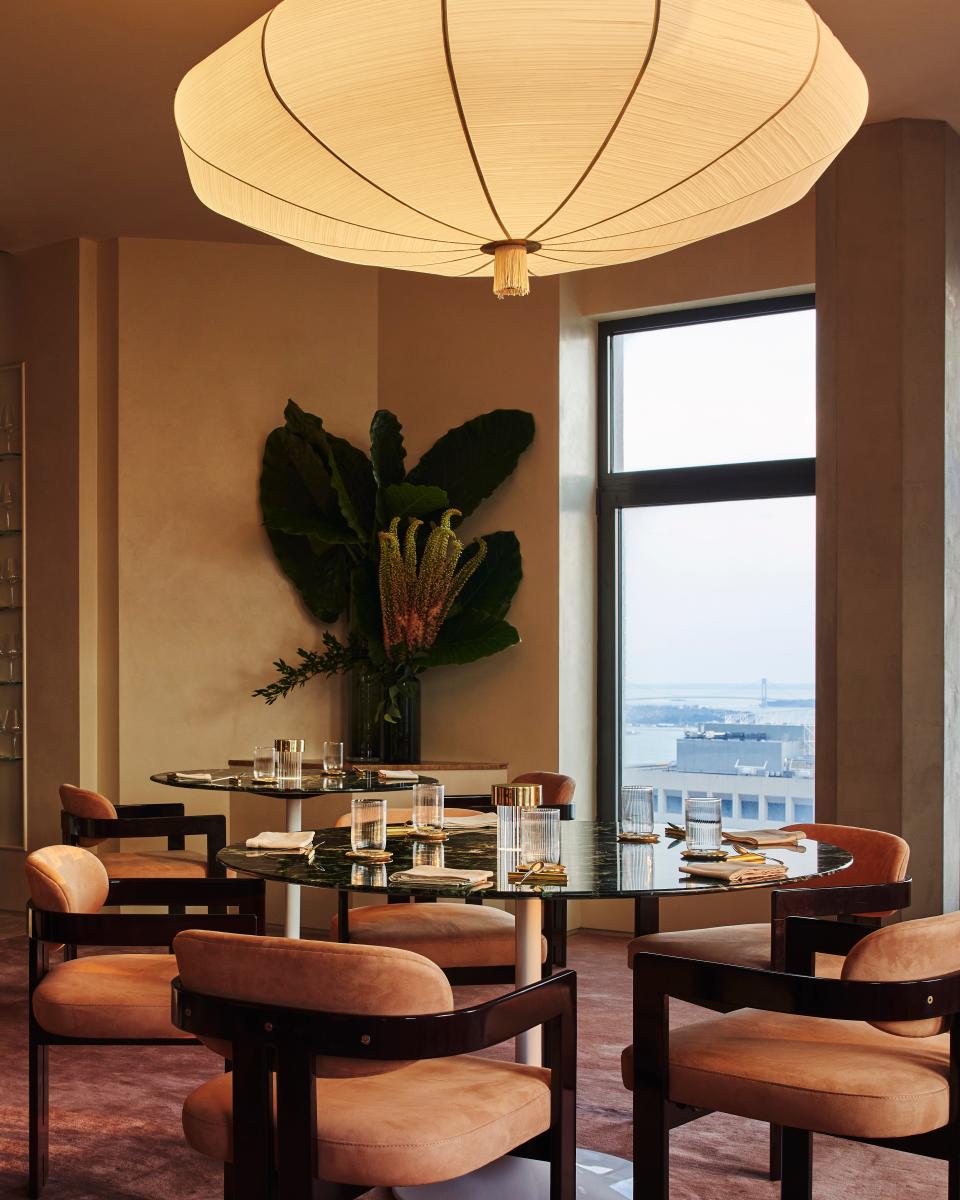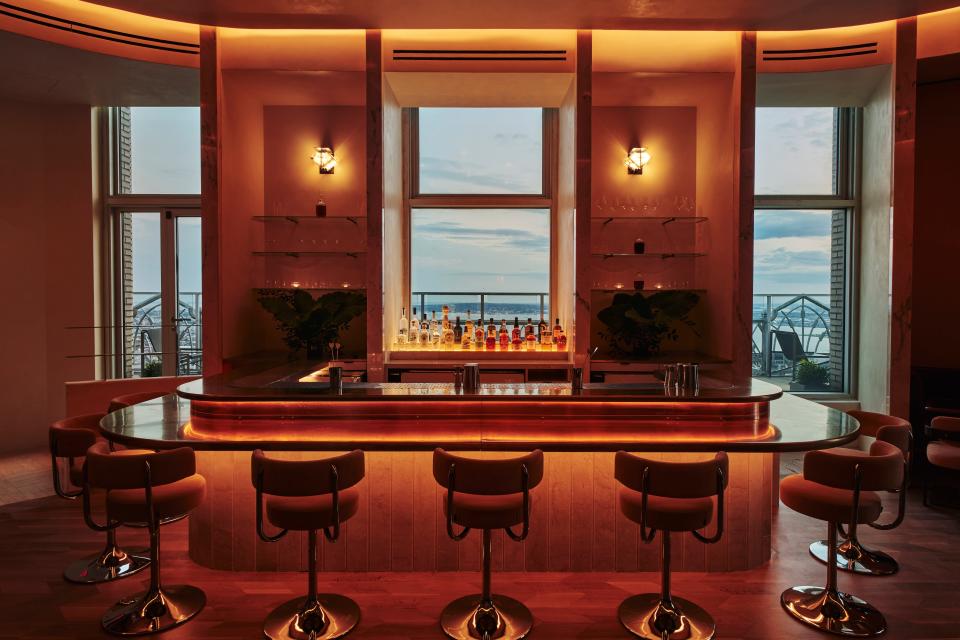SAGA Sets a New Standard for Sky-High Dining in New York City
In the 63-floor ascent to SAGA, James Kent’s newest restaurant, ears pop and lights dim as you make your way to the top of an Art Deco spire. When the elevator doors finally roll open, they do so onto a visually arresting bar with bowed palm leaves in upper corners and woven cane screens that seem to ripple as you look at them, separating just arriving guests from the dining rooms beyond. This is the culmination of a collaboration between Kent (who boasts tenures at NOMAD and 11 Madison Park) and his partner Jeff Katz, with the added expertise of the young architecture firm MN who are independently responsible for the inviting interiors. Led by Jonathan Garnett, Preeti Sriratana and Steven Harper, the firm has quietly worked for the last four years to bring Kent’s most recent vision to life.

SAGA is a sharp departure from New York’s customary fine dining circuit. In addition to its lofty locale (occupying the 62nd, 63rd, 64th and 66th floor of the financial district’s 70 Pine) with its panoramic views of the city, the space also holds masterworks by Jean-Michel Basquiat, Victor Vasarely, and Egon Schiele. Guests are escorted from the vaguely tropical bar in the restaurant's entrance onto a nearby open-air terrace, where they can take in the sunset as they await the first of many delicate, classic cocktails.
Once introductory drinks are finished, a host appears, decked out in a Snowpiercer-esque uniform by PUBLIC SCHOOL and surprisingly chic Clarks Wallabees. They guide each party to the tables—Eero Saarinen’s tulips, of course—which are either pulled up to one of the dining room’s many curvy, velvet banquettes or otherwise scattered about with custom low-backed armchairs (color matched to a Christian Dior oxblood nail polish) that hug you regardless of what position you sit in. Suspended from the center of one dining room is an oversized paper lantern, not quite Noguchi (a bit plumper, with the most minimal of tassels hanging from it’s center). Pierre Chareau sconces emit an additional soft glow, picking up textural notes from the marble topped tables.

Despite its intentional interiors, the restaurant’s atmosphere is almost domestic, without the pretension of a traditional fine-dining establishment. The discreet guest could even slip off a shoe, enjoying the plush peach wool Bokara carpet underfoot, which works double duty keeping the sound level to a low buzz.
In such an irresistibly comfortable environment, the innumerable courses of Kent’s sophisticated menu come almost as a surprise. You might be settled in, but the first course—an “icebreaker” consisting of frozen and compressed watermelon and hibiscus garnished with nasturtium leaves, which breaks apart with the slightest tap—commands attention.This refreshing first bite is followed by a series of nostalgia-inspired, complex dishes that are designed (with plating, scale and coloring very much in mind) to welcome the guest into Kent’s personal history. The food takes you on a journey. Childhood summers fishing off the side of his grandmother’s Sag Harbor house boat are evoked by a multi-fluke offering stacked on an etagere (including marinated fluke topped with crème fraîche and trout roe, kombu-cured fluke with shiso, citrus-cured fluke with honeydew, bruléed fluke rib with mushroom, escabeche fluke chop with jalapeño and fluke leche de tigre). A “Birds and the Bees” course serves up squab, duck and quail in three different stages of curing and preparation, complemented by a decidedly bao-like savory bun stuffed with the finest parts of all three fowl. Aside from these many-layered dishes there is a royal sturgeon caviar with a brown butter crumble and bonito, a “laminated” focaccia, a chanterelle custard with foie gras and vin jaune, and a grilled Maine lobster brûléed with sea urchin béchamel and hearts of palm.

Each dish is exciting, but not overwhelming. Relaxation is encouraged by the Sade and Erykah Badu-inspired playlist—a well-balanced mix of early 2000 R&B classics and more obscure, contemporary sounds in an adjacent vein. Movement is introduced into the meal via a short walk over to the restaurant’s solarium, located directly opposite from the pastry kitchen. Moroccan tea is served here, another nod to Kent’s culturally rich upbringing (and his given name, Jamal), and the guests are left alone to take in yet another arresting view of the city. Shortly after you’re escorted back to the table, dessert arrives in the form of roasted stone fruit with sesame and honey, accompanied by a “candy store” caddy of individually packaged, bite-sized delights. To top it all off, literally, guests can make their way upstairs to the restaurant’s oval bar, OVERSTORY, which takes visual queues from Art Deco ocean liners with wrap-around views of downtown Manhattan.

The experience is remarkable even without diving into the history of the space that Kent, Katz and MN—who collaborated closely with developer Nathan Bruckner at DTH Capital—used as their canvas. 70 Pine Street, where the restaurant is located (also the home of Kent’s Crown Shy) was built in 1932, and the floors now taken over by SAGA were occupied by illustrious Jazz Age bachelor H. L. Doherty of the Cities Service Company. Where we dine now, he once dozed—in a motorized bed that swung out to the balcony for direct nocturnal access to the New York sky. In respect for the space, MN took its inspiration from non-traditional interiors of the period—Villa Necchi Campiglio, for instance, the same grand old house featured in Luca Guadagnino's film I am Love. Other apt references include Carlo Mollino’s texturally rich Turin apartment and, perhaps less expectedly, Martha Cooper photos of Rock Steady, battling at Lincoln Center in 1981. The varied points of reference make for a considered, cohesive and iconic experience, but the true goal of the space is to make anyone who enters—regardless of their background—entirely welcome. “I want people to feel comfortable,” says Kent. “We want you to feel like you can come here, let your hair down and still have an amazing experience and thoughtful service. This is not a place you need to sit up straight in or button your shirt all the way up to the top.” Kent and his partners have created the perfect atmosphere for a winding, intimate narrative. The perfect story—a saga.
SAGA opens on August 24.
Originally Appeared on Vogue

